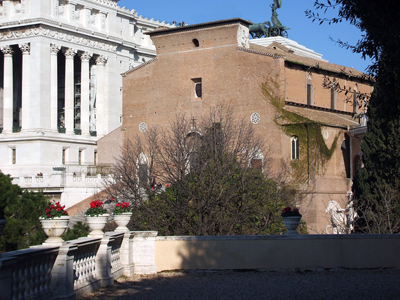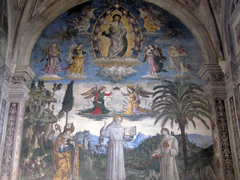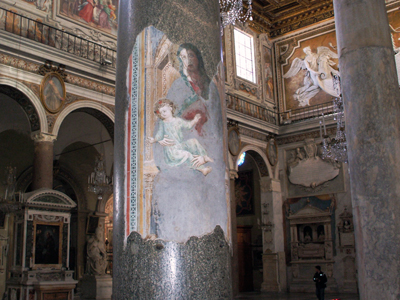SUN AN’ SOUL - DREAM AN’ ROME
SANTA MARIA IN ARACOELI
 |
| Santa Maria in Aracoeli - click to enlarge |
Santa Maria in Aracoeli owes its name to a popular legend, according to which in this place the emperor Augustus heard a voice saying: "This is the altar of God's Son". From here Aracoeli (ara = altar, coeli = heaven).
Here in the seventh century arose a Benedictine monastery, later in the mid-twelfth century it was built a Romanesque style church, with the entrance towards the Capitol.
In 1250 Pope Innocent IV gave the church to the Franciscans, who expressed the anxieties of the time and the desire for change. The Franciscans made it their general house and rebuilt the church in Gothic-Romanesque style, orienting it towards the Basilica of San Pietro. It is thought that the design was the work of the great Arnolfo di Cambio, while the interior decoration was largely the work of Pietro Cavallini.
The Franciscan consecrated the church at the end of 1200, but in reality the construction was finished in 1348, with the great staircase with 122 steps, lined with marble taken from the Colosseum. In 1797 when the French occupied Rome, they expelled the Franciscans and made a stable of the church, after having destroyed, or stolen, most of the furniture.
The last shot, and perhaps the most violent, was inflicted since 1880, when to build the Victorian it was razed to the ground the entire monastery complex, including the tower called of Paul III.
 |
| The Victorian - click to enlarge |
The façade we see today is the Romanesque of 1300, on which there are three portals. You can also enter the church from the ancient entrance, which is reached going up from Capitolium square.
On the lunette above this entrance side, the beautiful mosaic of the Madonna and Child attributed to Jacopo Torriti, with Pietro Cavallini one of the great Roman medieval painters.
The interior has three naves separated by 22 ancient columns,
very different from each other.
Next to the fourth column of the nave there is the altar of Our Lady of Refuge of the Viterbo school.
Not to be missed the Bufalini Chapel, the first of the right aisle,
masterpiece of the great Pinturicchio.
 |
 |
 |
| Bufalini Chapel - click to enlarge |
In the fourth, on the altar and the walls stories of St. Matthew by Girolamo Muziano.
Next to the side pillars of the nave the two beautiful pulpits are by Lorenzo di Cosma and his son Jacopo.
In 1564 by the will of Pius IV was accomplished the unfortunate destruction of the apse, frescoed by Pietro Cavallini, the greatest Roman painter of the thirteenth century, who had taken care of most of the interior decoration. You can see along the right aisle what was saved of these frescoes.
In the left transept the monument of the Cardinal Matteo d'Acquasparta attributed to Giovanni di Cosma, in beautiful Gothic aedicule with a fresco of the Madonna and Child enthroned between Saints Matthew, John, and a cardinal, by Pietro Cavallini.
On one of the columns between the left aisle and the nave you can see the suggestive Madonna of the Column.
 |
| Madonna of the Column - click to enlarge |
In the third-chapel of the left aisle St. Anthony of Padua and two donors, by the great Benozzo Gozzoli, only surviving part of the frescoes that decorated the whole chapel.
The Solano chapel, the first of the left aisle, both in the architectural part and in the painting is the work of Antonio Gherardi, a great artist little known.
In the counterfaçade the tomb of Cardinal Ludovico D'Albert is the work of Andrea Bregno.
In 1571 here it was celebrated the Triumph of Marcantonio Colonna, commander of the Catholic League, who defeated the Turks at Lepanto. To celebrate the historic event was carried out the spectacular ceiling designed by Sermoneta.
back |

